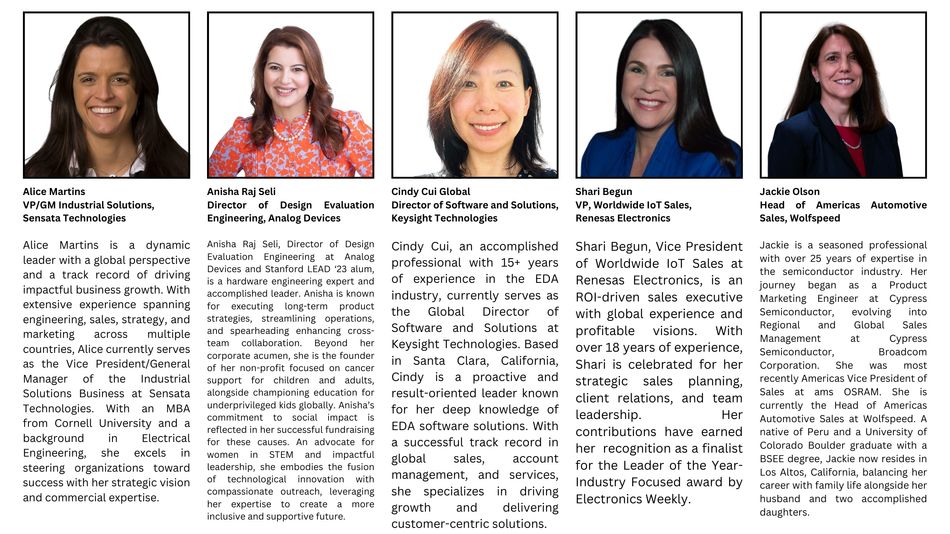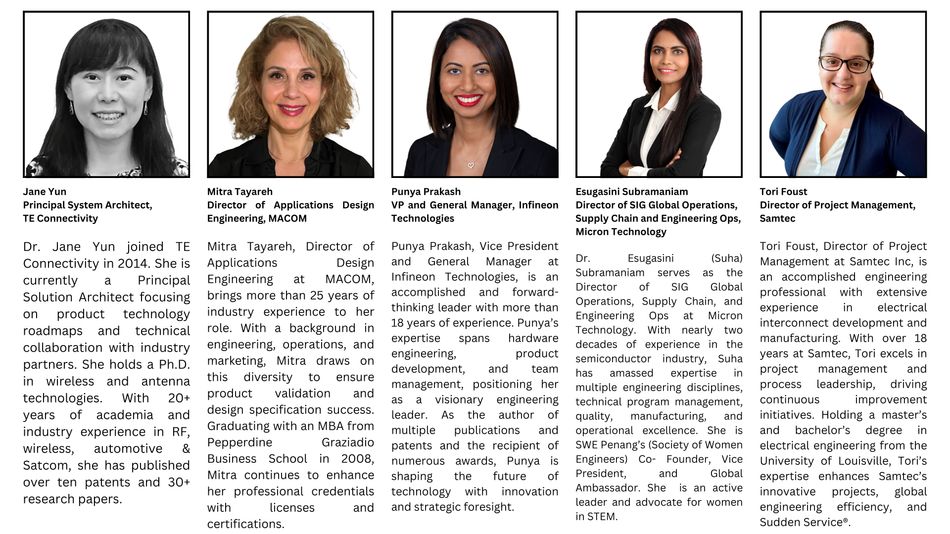Women in Engineering Leadership: Unlocking the Secrets of Influential Leadership
Article #1 of Women in Engineering Leadership Series: Discover how visionary women leaders are reshaping the engineering sector with their dynamic and inclusive leadership approaches, setting new benchmarks for innovation and inspiring a generation to break traditional boundaries.
Women have historically been underrepresented in engineering, a field dominated by men for decades. However, in recent years, remarkable women have been breaking barriers and setting new benchmarks in engineering leadership. These trailblazers are excelling in their respective areas and actively changing the narrative, proving that effective leadership is not bound by gender. Their contributions are enriching the engineering field and inspiring a new generation of engineers to pursue and excel in their careers.
Welcome to the first article in our multi-part series on "Women in Engineering Leadership," brought to you by Mouser Electronics. This series explores various facets of leadership through the lens of prominent female leaders in engineering who are paving the way toward a more inclusive industry. Each installment of this series dives into different aspects of leadership and professional development, underlining strategies, challenges, and key insights. Join us as we discuss the stories, challenges, and triumphs of women leaders redefining the engineering sector.
In this article, our panel of women in engineering leadership share their hard-won wisdom on inspiring, empowering, and motivating their teams. From fostering personal connections and leading by example to embracing failure as a learning tool, these leaders reveal the strategies that have propelled them to the top of their fields.
Meet Our Panel of Women in Engineering Leadership
We've convened a group of ten distinguished women leaders from the engineering sector, each sharing their unique perspectives on navigating and excelling in a traditionally male-dominated field.


Three key themes emerged from our interviews: strategies to inspire and influence teams, approaches to empower and motivate risk-taking and decision-making, and the importance of fostering relationships with team members.
Inspire and Influence Your Team
Leadership is about inspiring and influencing others toward a common goal, not just holding a position of authority. In today's work environment, simply relying on authority doesn't work.
Tori Foust leads a team of project managers at Samtec. As the director of project management responsible for executing critical engineering projects, she has plenty of hands-on experience managing teams and inspiring them to meet a common goal.
"I've learned to inspire and influence members of my team by being in their corner," says Foust. "I ensure they know I'm here for them and willing to help them." She continues, "People tend to stay in their comfort zones. I give them opportunities to try new things." She shares an example of someone on her team who needed to become more familiar with tools for risk management. Foust suggested that she talk to other people to help fill the gaps in her knowledge: "I worked closely with her to create a plan that empowered her. The most effective approach is where you collaborate with someone and provide them with the tools and confidence they need to take the lead and excel in their position."
Esugasini Subramaniam, who leads a global team as the director of supply chain and engineering at Micron Technology, shared her advice. “The 7 Habits of Highly Effective People® workshop helped me learn how to inspire and influence my team,” says Subramaniam. "Ten years ago, I set out to become a role model for women in engineering. Since overcoming a tough background, I've dedicated myself to personal growth, striving to be an inspiring leader others can look up to and turn to for guidance."
Subramaniam believes one way to inspire your team is to stop perpetuating the victim mentality: "When faced with a challenging situation at work, resist the temptation to play the victim. Instead, take a step back, analyze where things went wrong, and allow yourself to process your emotions. Then, channel that energy into finding a solution." In most cases, Subramaniam says she could see that the situation had started poorly. By using this self-awareness technique, she can better lead her team, influence them to be productive and make good decisions, and be a role model for others.
Jacqueline Olson, head of Americas Automotive Sales at Wolfspeed, inspires and influences by putting herself on the same plane as her team members. "As soon as I feel like I'm an authority, I feel the loss of connection to the team," says Olson. "Instead, I see myself in a position of service and responsibility. I have a responsibility to show the possibilities and remove obstacles to allow the team to be successful." Olson says that when her team succeeds, she succeeds—a win-win for everyone.
Empower and Motivate Your Team to Take Risks and Make Decisions
To empower your team to take risks and make decisions, Foust suggests leading by example and communicating the value of learning through failure. “Perfectionism and fear of failure are inherent to many women engineers," Foust admits. "As a leader, I encourage my team to embrace 'failing forward'—learning from mistakes and using those lessons to grow. Failure, with the right mindset, is the best teacher.”
“Empower your team to make decisions. Inclusive decision-making, involving all stakeholders, is key to business success and employee retention.”-Esugasini Subramaniam
Olson shares her advice for empowering her team to take risks and be more productive: "For people to take risks, they need to feel safe to make mistakes. This is where the learning and growth comes in. As leaders, we have to be supportive in this process.”
Dr. Jane Yun, a principal system architect at TE Connectivity with over twenty years of experience in academia and industry, believes that setting the right expectations is critical for leaders who want to motivate their teams in today’s work environment: “Effective decision-making requires the right tools and methods. Before starting a project, teams should clearly define what failure looks like. By understanding the consequences upfront, you can prevent or mitigate the impact of missteps. Empower your team to make the right decisions by clarifying what to avoid."
Make Personal Connections with Team Members
To lead confidently and influence others, Alice Martins, a VP and GM at Sensata Technologies responsible for nearly 20 percent of her business's total revenue, recommends creating person-to-person relationships with team members. "I'm personable, and having a personal connection with team members is critical," says Martins. “Collaborate on problems to strengthen team bonds. Solving challenges fosters relationships, builds trust, and accelerates progress while engaging everyone."
Mitra Tayareh, the director of application design engineering at MACOM, offers similar advice. While communicating as a leader to your direct reports can help speed up productivity and increase employee satisfaction, bonding with each other is just as critical—and it’s the leaders’ responsibility to make that happen. “We have open lines of communication within my group and with other team members,” says Tayareh. "More often than not, talking to other people solves problems. I advocate for my team to communicate openly—that's how we get more done."
Prepare Future Leaders
Overcoming challenges in your career is difficult. Many women struggle to quiet their inner critics, step beyond fear to make empowered decisions, and stand up for themselves or others in the workplace. Our experts have advice for future leaders on these specific challenges.
Know Your Worth
Foust shares that throughout her career, she often participates in conversations that—on the surface—seem outside of her scope. “But I've learned to recognize my worth. I take a step back and think about why I'm here. I'm likely here for a specific purpose," says Foust. "I think through what I bring to the table and let others fill the gaps I don't have."
Your "inner critic" may say you don’t belong, but Foust suggests breaking through that barrier by asking questions to discover how to contribute. Observe the conversation, remind yourself of your talents and abilities, and then ask questions to add to the solution.
Step Outside of Yourself
Through confronting her insecurities, Olson finds that the best way to tackle an assignment is to shift focus from yourself to the steps needed for completion. Like many professionals, she struggled with self-doubt and imposter syndrome throughout her career. To overcome these challenges, she suggests focusing on the task at hand and setting aside self-doubt. "I concentrate solely on what needs to be accomplished and then identify the steps required to get there," she explains. Using a metaphor, she illustrates this approach: "Imagine parking your doubts in the parking lot. There, you leave them behind. Then, you enter the office and focus solely on the tasks that will propel you toward your objectives.” By consciously setting aside fears and doubts, leaders can overcome imposter syndrome and excel in their responsibilities. "List what you need, identify who to talk to, and push through your insecurities. Take yourself out of the equation and focus on the task at hand," says Olson.
Help Your Team See the Bigger Picture
Punya Prakash, a VP and GM at Infineon, a leading semiconductor company, recommends that leaders identify a leadership style that can help them show their team the bigger picture. This perspective allows team members to push boundaries and achieve greater success. "To help your team take risks, you must begin by removing the fear of failure,” says Prakash. “Help your team see that with high risks, there is potential for high reward. If mistakes are made, the team can learn from them and do the work better and faster the next time around.” She explains that teams can lose sight of this bigger picture as they work through daily goals.
In another example, Cindy Cui, director of software solutions at Keysight Technologies, finds that her sales team is most successful when they broaden their perspective. “I mentor my team to qualify opportunities and analyze ROI before investing significant efforts or taking action and to use these metrics as guidance for decision-making and risk-taking,” Cui explains. “This methodology helps my team deliver outstanding results year after year.”
Conclusion
As we reflect on the wisdom shared by our panel of women leaders, three pivotal strategies stand out for fostering effective leadership:
Cultivate Personal Connections: Prioritize creating personal relationships with your direct reports and actively facilitate these connections among team members to build a cohesive and supportive work environment.
Encourage Risk-Taking: Empower your team by removing obstacles and clearing the way for them to experiment and embrace new challenges. This openness fosters an innovative mindset and drives progress.
Define Parameters of Failure: Before embarking on new projects, clearly define what failure looks like. This clarity helps your team understand the boundaries within which they can operate, making them more confident and effective in their decision-making processes.
By implementing these strategies, women leaders in engineering enhance their teams' performance and are paving the way for more inclusive and dynamic leadership styles in the industry.

This article was initially published in "Women in Engineering Leadership: Advices and Best Practices for New Leaders," an e-magazine by Mouser Electronics and IEEE Women in Engineering Society. It has been substantially edited by the Wevolver team and Ravi Y Rao for publication on Wevolver. Upcoming articles will explore various aspects of leadership and best practices for new women leaders in the engineering field.

